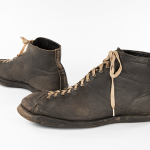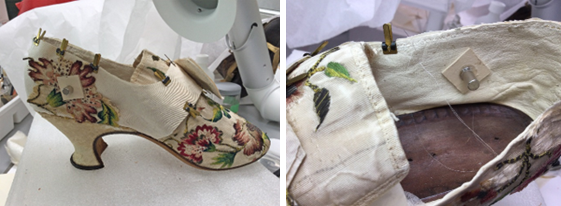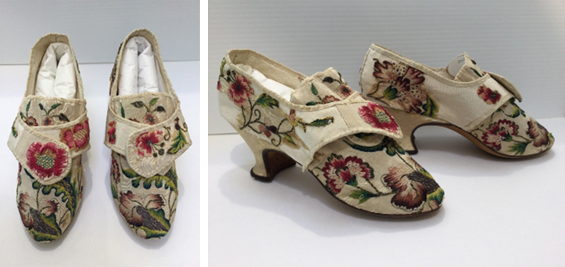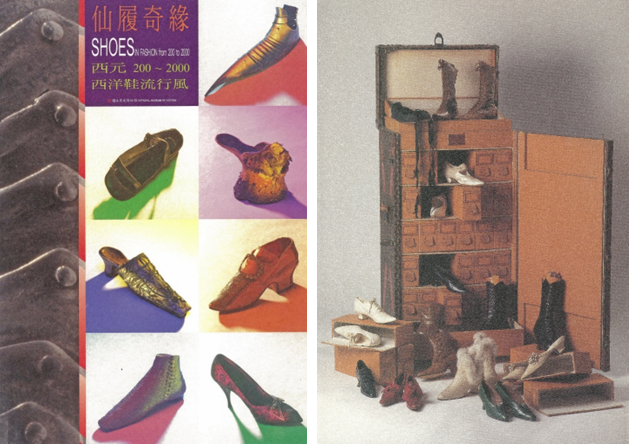I am retiring this summer and thought my last conservation treatment should connect to the first one. Thirty-four years ago I was hired to work on the women’s 18th century collection. It was a unique moment, as there was a BSM collection but no exhibition space. Myself and another conservator conserved the footwear that was most in need of intervention.
These shoes were purchased in 1982 from a dealer specializing in historic clothing and accessories. While the embroidered silk faille vamps were very pretty, it was obvious someone had fiddled significantly with the quarters on both shoes. Remnants of the original silk faille were glued to a figured silk satin. Random embroidery elements some original, a couple with a completely different aesthetic, were also glued to the replacement fabric.
The flower on the left is a completely different style than the finely executed flower on the right.
The adhesive was disfiguring and damaging. It was an orangey-yellow colour, composed of brittle islands on the silk, as well as the leather lining to which it had been attached. The hard patches of adhesive were cutting through the desiccated fibres of the remaining faille. In several of areas the adhesive had dried out causing losses of embroidery, as witnessed by adhesive stains to which nothing was attached. The original silk ribbon binding was extant along the top edges of the tongue extensions but completely missing along the tops of the quarters. It had been replaced during the previous ‘restoration’.
After discussing these issues with the curator it was decided the figured silk satin should be replaced with a silk faille, the adhesive residue should be removed as much as possible and the replacement ribbon would be reused. Solvents were tested to determine which one would be best at removing the disfiguring adhesive. The topline ribbon was removed first, by clipping the stitches with a pair of curved blade scissors to prevent nicking the original fabric. Then the adhesive securing the original fabric to the replacement needed to be reduced in order to detach these components, and finally the quarters were removed.
Left: adhesive stains Right: removing adhesive residue from embroidery
The original faille was ivory but over time developed a very faint brown discolouration. The new faille, and hair silk for sewing, were dyed with tea to impart an aged appearance. The most complete replacement quarter was used as a template from which to cut the new quarters. It was lasted into the sole seam with a reversible adhesive and a spatula, taking into consideration that the weave of the new fabric needed to match the direction of the weave of the original remnants. The quarter was secured to the leather lining with tiny clips and rare earth magnets as anchors. The new fabric was sewn with hair silk and a fine beading needle that was passed through existing stitch holes along the topline.
Finding a replacement ribbon similar in weave and width to the 18th century ribbon is virtually impossible, at least I have yet to find a suitable source. The topline binding that came with the shoes was sewn back in place using the same technique as for the new quarters (hair silk, beading needle).
The treatment has stabilized the original fabric to prevent further damage, resulting in a shoe that looks more in keeping with the intention of the shoemaker.








